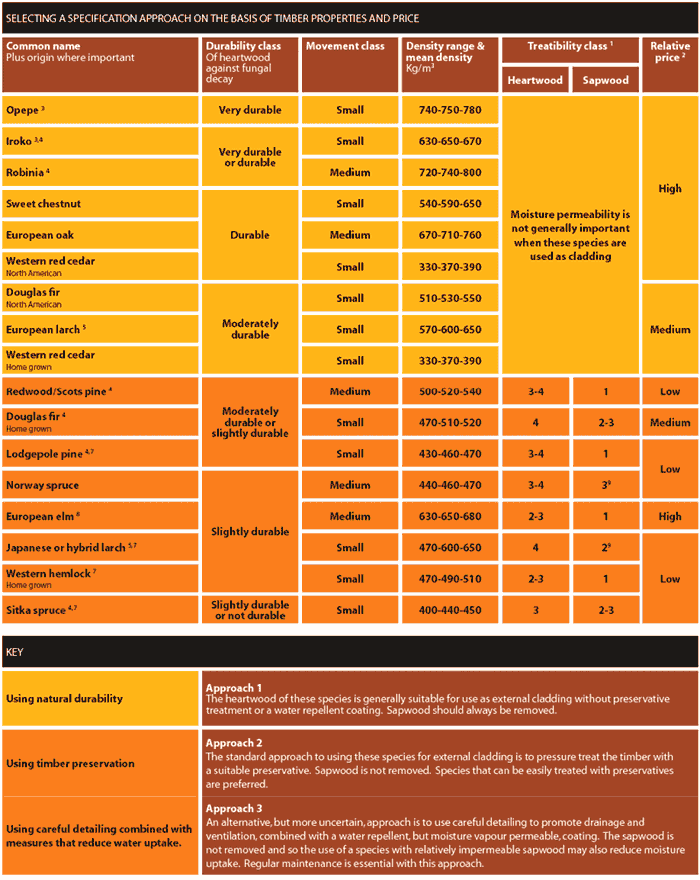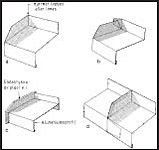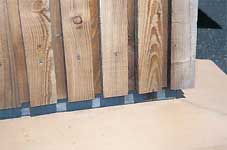Timber cladding in Scotland
The study outlines the development of timber cladding in Scotland, describes timber clad buildings in Scotland, and provides practical information on the use of timber cladding in Scotland.
Timber Cladding in Scotland
3 USING CAREFUL DETAILING COMBINED WITH MEASURES THAT REDUCE MOISTURE UPTAKE
An alternative (but much more controversial) approach to using timber of low natural durability in Hazard Class 3 conditions is to avoid using wood preservatives and instead to use careful detailing in combination with a water-repellent but moisture vapour permeable coating which is regularly re-applied. The use of timbers with relatively impermeable sapwood (e.g. Norway spruce) may also be beneficial. This approach is widely used in Scandinavia (including the western coastal zone). In Scotland it is used by some window manufacturers and is surprisingly commonplace with timber cladding. Indeed it is probably the most common approach to specifying timber cladding on housing.
Although this approach is implied in BS EN 460: 1994 it is not explicitly described in any of the current standards and there are many uncertainties and anomalies surrounding its use. Consequently the comments given here are only intended to highlight the approach and the uncertainties surrounding it. Further research is needed and, until this becomes available, these techniques should be used with caution.
In this approach the use of careful detailing to promote drainage and ventilation is the most important factor, and where such detailing for durability is not present, surface coatings by themselves do not provide sufficient protection against biological degradation. Consequently, this approach requires a much higher standard of detailing, site practice, and maintenance than is common in the UK construction industry.
Where detailing is poor, the service life of the component will be very limited. The draft European Standard DD 239:1998 quotes a minimum service life of only 15 years for slightly-durable or not-durable timbers used in Hazard Class 3 conditions without preservative treatment. This is probably correct when poor detailing and site practice is in evidence, but in western Norway the service life of cladding designed for durability and suitably coated is generally accepted as being around 50 years, even where slightly-durable or not-durable timber is used. Severely exposed coastal sites will reduce this service life and in such conditions the use of other approaches (i.e. preservative treatment or naturally-durable heartwood) is recommended.
This approach is generally acceptable under Part B2 of the Scottish Building Regulations providing that the cladding is designed to be easily repaired or replaced should decay occur and that, were a component to fail, it would not pose a structural or health and safety hazard. Where structural or health and safety considerations exist, preservative treatment or naturally-durable heartwood should always be used.
There are a number of useful questions which help identify the most suitable species or group of species for use in specific timber cladding situations:
|

NOTES ON THE TABLE
1 Treatability is used here as a broad indication of the moisture absorbing characteristics of a timber. Although originally intended as a description of how easily a timber can be penetrated with preservatives, treatability is also used in BS EN 350-2:1994 to describe the permeability of timber in service. In this standard easily treated timbers are therefore assumed to be highly permeable to moisture and vice versa (It should be highlighted that treatability does not directly equate to permeability to moisture and that this is a complex issue in need of further investigation) The classification used in BS EN 350-2 is as follows:
Class 1 easily treated
Class 2 moderately easy to treat
Class 3 difficult to treat
Class 4 extremely difficult to treat
2 The following figures indicate the relative prices of cladding timber:
High These timbers are expensive and, in 2000-2001, were generally priced at between 20- 35m2 when sold for cladding.
Medium These timbers are about half the price of durable or very durable timbers and, in 2000-2001, this cladding was generally priced at 10- 15m2
Low These timbers are about half the price of moderately-durable species and, in 2000-2001, cladding from these timbers was generally priced at 5- 7m2.
Elm cladding boards cost around the same as durable timbers such as oak. This may seem anomalous, but until the mid-20th century elm was considered a low-value utility wood. Availability has declined since then due to Dutch elm disease;
3 Tropical species may be protected under the Convention on International Trade in Endangered Species. If in doubt, proof of independent forest management certification should be requested;
4 Where the durability of a species spans two durability classes, designers generally have no alternative but to assume the timber is in the lower class. This is a common problem with Douglas fir where homegrown timber is incorrectly assumed to be of equivalent durability to that originating in North America, see BS EN 350-2: 1994
5 The standards do not distinguish between the durability of the three larch species, all of which are grouped as moderate- to slight-durability. The separation between European larch and the other larch species given in the table is based upon anecdotal trade experience in the UK(4);
6 In addition to the low-durability class identified in the standards, anecdotal information suggests that homegrown western red cedar tends to be more knotty than North American timber and may be prone to drying problems;
7 In Scotland or Scandinavia, there is little experience of using these species for external cladding. Inclusion in this table is based upon their timber properties or on their use for external cladding in North America. Until more experience is gained in using these species for cladding in Scottish conditions it would be prudent to assume a limited service life or to impregnate the timber with a suitable preservative;
8 Where waney-edged elm boards (i.e. boards with sapwood) have been used for cladding it is likely that the boards were given a superficial coating of tar oil;
9 The sapwood of these species have variable treatability characteristics.
The main information source for the above table and these notes is BS EN 460: 1994.
Additional points of interpretation are drawn from:
BS EN 350-2: 1994;
DD 239:1998;
TRADA, 1997(4);
Hislop, 2000(3);
Byggforsk, 1998(5);
Hamilton, et al., 1993(6) ;
and E & FN Spon, 1992(2).
TIMBER QUALITY Specifiers should always state the required quality of the finished cladding in order that suppliers know what level of defect is acceptable. The selection of suitable timber then normally happens in two stages - the supplier first selects suitable boards taking into account the species, whether it is to be painted or not, and whether sapwood is acceptable. This is then delivered to site where a further selection is made as the boards are being fixed. Where there is any uncertainty as to the timber quality required, the National Building Specification recommends specifiers request advance delivery of a small sample of the cladding boards so that a final quality specification can be agreed. To avoid subsequent dispute, the sample should include examples of the lowest quality which will be supplied. BS 1186-3:1997 gives limits for the size of knots and knot clusters and, largely on this basis, grades timber into four classes: CSH, 1, 2 or 3. CSH grade is the most expensive as it limits the knots to a maximum of 6mm diameter. The other grades set varying limits on knot size depending upon the width of the board: CSH - Not generally relevant to cladding as it is mainly intended for the grading of very small profiled sections. It is, however, suitable for very prestigious flush cladding panels made from tropical hardwoods or carefully selected European oak; Class 1 - Suitable for most cladding designs where planed and flush jointed panels are used. It is generally available in imported Douglas fir and western red cedar, plus all the main hardwood cladding timbers, except elm. Where cladding boards are within normal sizes (i.e. circa 100-150mm wide) this class limits the diameter of sound knots to 22.5mm; Class 2 - Generally considered suitable for unpainted boards in homegrown European larch. Many timbers of low-durability are also available at this grade. Where cladding boards are within normal sizes (i.e. circa 100-150mm wide) this class limits the diameter of sound knots to 35mm; Class 3 - Generally considered adequate for painted cladding boards. Where cladding boards are within normal sizes (i.e. circa 100-150mm wide) this class limits the diameter of sound knots to 50mm, or no more than 35% of the board width. The standard distinguishes between the exposed and concealed surfaces of boards. Dead or unsound knots are permitted on exposed surfaces providing they are not loose. No limit is placed on the size or tightness of knots on the concealed face of boards. The standard also places limits on other features such as splits, resin pockets and grain angle. Sapwood is the most important of these, and the standard requires it be removed from the exposed faces of cladding boards unless the timber is to be pressure-treated with preservative. As already noted, the Scottish Building Regulations may permit this recommendation to be relaxed in some circumstances, providing sufficient care is taken with the detailing. Sapwood should, however, always be removed from more durable timbers such as European larch or European oak (there is no point in incurring the additional costs of using these timbers if removal of the sapwood is not insisted upon). |
DETAILING FOR DURABILITY
All too frequently, exterior joinery such as cladding is designed with water traps and other details which put too much reliance on natural durability or preservative treatment. This should be avoided and the principals of detailing for durability should always be the first line of defence against decay. The principles of detailing for durability are (7):
- To prevent wetting of the timber wherever possible;
- To ensure rapid drainage and adequate ventilation in situations where it is impossible to avoid wetting;
- To use naturally-durable or preservative treated timber in situations where wetting will be persistent.
In the context of external timber cladding using a drained and back-vented rainscreen approach, these principles can be expressed as the four D's: Deflection, Drainage, Drying, Durability (8). The rainscreen serves to deflect most of the rain that would otherwise get blown into the wall. Any water that does get blown into the cavity is able to drain harmlessly away, aided by the drying effect of a cavity which has unrestricted airflow to the exterior. Finally, all the materials used to construct the rainscreen should be sufficiently durable to resist damage from moisture. The four D's provide a useful framework when considering the detailing of external timber cladding in exposed maritime climates.
DEFLECTION
Using architectural features (such as eaves) to control water sources by deflection can have enormous benefits in a maritime climate. If most water is diverted before it impacts on, or is able to wet, the wall then the requirements for drainage and drying mechanisms are considerably reduced.
OVERHANGS
A survey of building failures in the coastal areas of British Columbia (9) identified a direct relationship between the frequency of problems and the width of the eaves overhang. Large eaves could be beneficial on low-rise buildings in Scotland, though this recommendation requires cautious interpretation when applied to very exposed sites (e.g. the Western Isles) where uplift forces due to wind acting on a building can be severe. The provision of large eaves is not generally a part of 'traditional' building practice in Scotland, however, and there may be planning issues where such details are proposed in close proximity to more traditional buildings. Interestingly, 19th century railway stations in Scotland have large eaves.
TOP FLASHINGS
Where large eaves are not appropriate, it is still vital to protect the top of a cladding panel, with a flashing used to deflect water off the wall and protect any endgrain that might be exposed to wetting. The normal UK recommendation is for the flashing to project from the wall by 50mm. Any intermediary flashings at storey height should have similar projections (10).
SPLASHLINES
A common detailing failure occurs where timber cladding has been taken too close to the ground or other horizontal surface. The base of a wall is always subject to splashes of water and serious wetting can occur if the timber is not kept above this 'splashline'. In the UK and Norway, the recommendation is a gap of at least 100mm where the splashing risk is minimal, though a gap of 150mm would be preferable in most cases. A gap of 250mm or more is required below any exposed walls where the risk of splashing may be high (3, 5).
SHELTERED OPENINGS
If moisture problems are to be avoided, the detailing of windows and door openings through the cladding requires particular care. Air leakage and penetration of driving rain at the sides and base of windows are the greatest problems. In exposed conditions windows and doors should be set well back in the wall section and fixed to the inner leaf of the building in such a way that they will be sheltered and not exposed to water running down the inside of the cladding (5, 11).
These details are recommended in Scotland, but are much less common in England and Wales where windows are often set forward in the outer leaf of the wall section. Unfortunately, because much of the technical guidance available in Scotland is produced for English conditions, it is sometimes difficult to find window and door details suitable for exposed sites and, as a consequence, inappropriate window details are frequently used. By contrast, Norwegian recommendations (5) provide examples of window openings in timber-clad buildings designed for the full range of Scandinavian climate conditions and their approach should be adopted in the UK.

|

|
Norwegian and Canadian recommendations stress the importance of good flashing design above and below windows. Note the use of vertical upstands at the back and sides. |
Timber should be kept above the ˜splashline' - in this case the minimum 100mm has been used, although in most cases a larger gap of up to 250mm offers better protection. |
Contact
Email: Central Enquiries Unit ceu@gov.scot
There is a problem
Thanks for your feedback